How to play the accordion correctly?
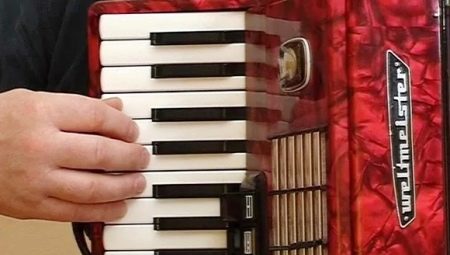
The accordion was invented 200 years ago, but it is still a popular musical instrument due to its rich timbre sound, which differs from other related instruments. Modern accordions differ in the right-hand keyboard: button accordions like button accordions and keyboards with piano keyboard. This article covers only keyboard models - that is, those with which most people associate the word "accordion".
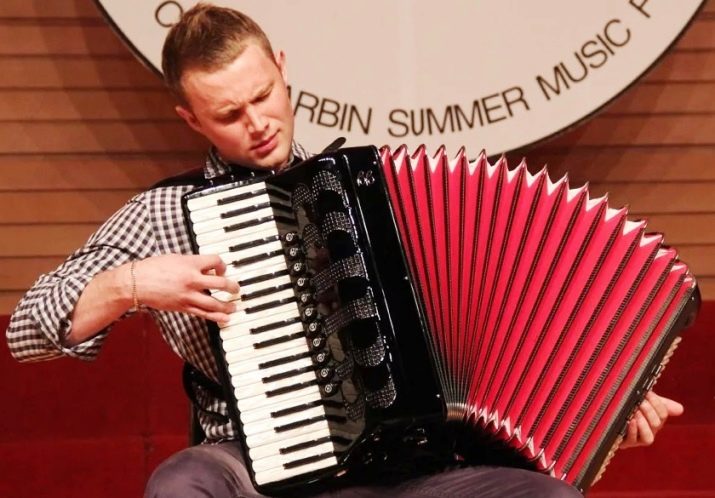
How to sit properly?
Learning on any musical instrument begins with getting the skills to properly fit with it (or "behind it", if you recall the piano). This is where practical accordion lessons begin.
You can play the accordion not only while sitting or standing, but also moving in any direction. Beginning musicians should still learn to play this instrument while seated. The accordion is a rather heavy thing, so there is no need to bother oneself without the need for such a burden, even for an adult, not to mention children.
It is better for young learners to choose a tool that suits their age and height individually.
In addition to the complete accordion, there are also smaller models on sale, which make up the following parts from the complete accordion:
- 7/8 pieces;
- 3/4 part;
- 1/2 part.
For younger students, half (that is, 1/2) models should be purchased, for 10-12-year-old children 3/4 accordions will fit, and for older ones - 7/8 or full.
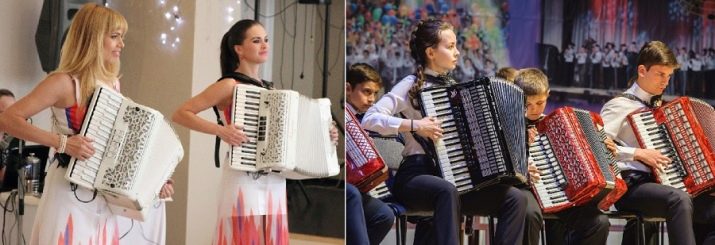
Sit or stand straight. In a standing position, you need to lean evenly on both legs, which are better to be slightly spaced for balance.
In the sitting position, there are 3 options for the legs.
- Knees closed, feet close. This fit is more practiced by accordionists in short dresses.
- Legs apart (width is chosen individually), feet in a straight line relative to the body.
- Legs apart, as in the previous paragraph, but one of them moves forward a little (usually the one on the thigh of which the right keyboard part of the instrument rests: for women it happens to be the right, for men it is always the left). In this case, the foot of the other - free - leg moves slightly backward (under itself) with the simultaneous lowering of the knee.
You need to sit on a hard chair so that the back muscles do not get tired, the spine does not overload. Only part of the seat (1/3 or half) should be occupied. It is not necessary for this:
- lean back in a chair;
- lean forward;
- slouch;
- be in a confined space (especially on the left side).
The chair is selected in accordance with the height of the musician: with a free fit, the knees should be parallel to the floor, the feet are completely located on the plane of support.
Young accordionists who do not have low chairs should look for a footrest.
How to hold the accordion?
The accordion has 2 keyboards - melodic for the right hand and bass with ready accompaniment for the left. In the right keyboard, the full instrument contains 41 keys, and in the left one has 120 buttons. In smaller instruments, the vocal and accompanying range is also smaller: from 26 to 37 melodic keys and 24-96 bass-chord buttons.
The right keyboard is fixed in a fixed position. It is mainly placed on the musician's left thigh. The left keyboard should be free to move the bellows.
The accordion has 2 adjustable shoulder straps attached to the right keyboard section of the body. One strap is worn over the accordionist's right shoulder and the other over the left. Other models have a bridge connecting both straps behind the musician's back. For lightweight play in a standing position, even waist belts have been created.
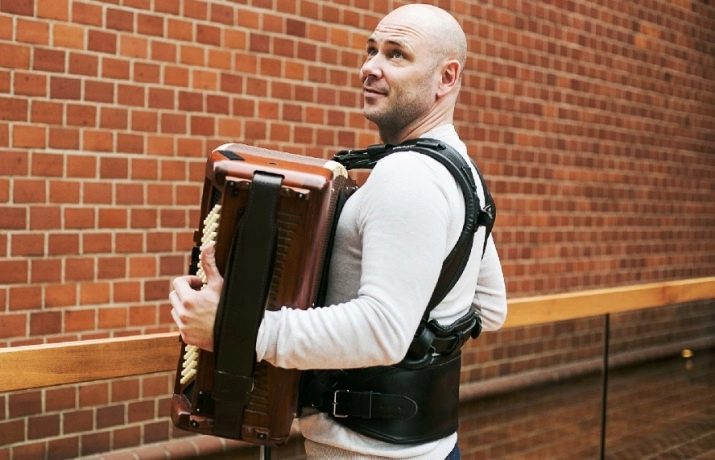
On the left - button - part of the body, there is an end strap that fixes the left wrist of the accordionist, allowing him to move the bellows along with the bass keyboard.
When playing the accordion while seated, it is important to secure the instrument firmly to the knee of your left foot using the shoulder straps.
On this musical instrument, which has keys in the right keyboard, the right hand is in no way involved in supporting the instrument.
It should be absolutely free, performing only the function of ensuring the movement of all 5 fingers on the keyboard. It is due to the support of the lower part of the right keyboard on the knee of the leg and the careful adjustment of the shoulder straps that the instrument is firmly fixed. The straps should hold the accordion tightly against the musician's chest.
The end strap (on the accompanying side) also needs to be adjusted according to the hand so that the wrist is firmly pressed against the side cover of the case, but at the same time does not interfere with the free movement of the fingers along the keyboard.
At the initial acquaintance with the right keyboard, it is allowed to slightly tilt its plane so that the beginner can see not only the keys themselves, but also the position of their fingers and hands. In the future, it is better to avoid the habit of "prying" the keys and fingers.
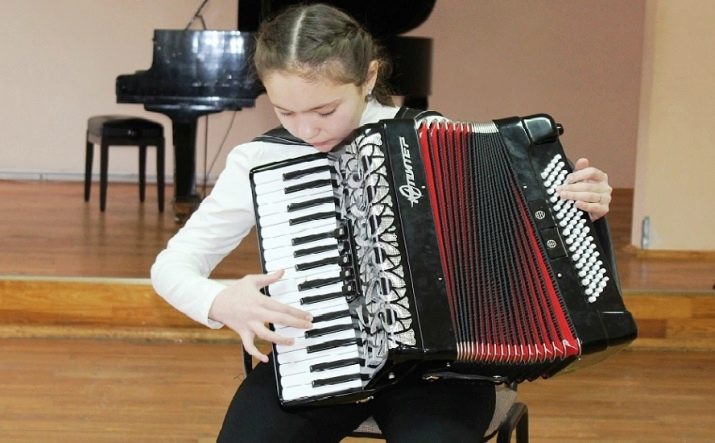
Technique of the game
The left keyboard has a complete resemblance to the 5-row button accordion, and the right one is slightly less in range than the button accordion. But accordions are equipped with right-hand keyboard registers that change the pitch and timbre of the instrument, which allows you to expand the melodic range. The accordion has no registers for changing the pitch of sounds.
There are several ways to learn how to play the accordion.
- With the help of a private tutor... This is how both children and adults learn.
- In musical school. The most common method for primary school children.
- To himself by self-study guide, school or other teaching aids.
- By yourself by hearing, if there is one by nature.
Each method has its own advantages and disadvantages, but the most reliable in terms of the final result are the first two of the named, where training takes place under the supervision of professionals. The specialist will teach you how to play the instrument correctly, protect you from mistakes in hand positioning, fingering, and fur movements.
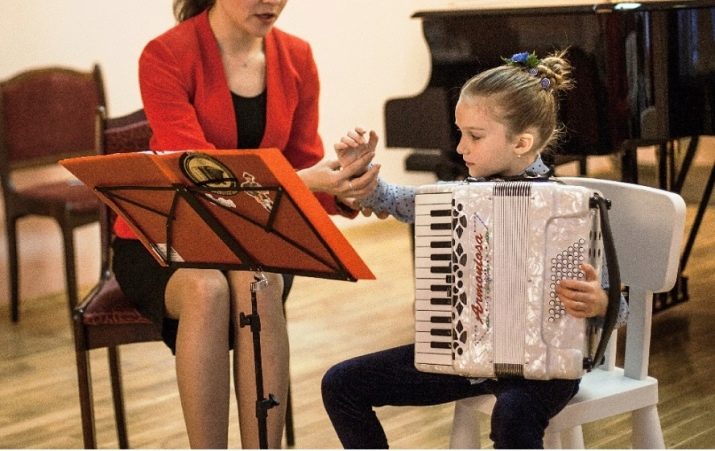
Unfortunately, many mistakes "self-taught" and "listeners" cannot avoid, and they often become an insurmountable barrier on the path of development of amateur musicians.
Teaching children and adults to play a musical instrument from scratch should be different.
Parents bring the children to study. At the same time, the children themselves do not always want this or do not quite understand what they will have to do. That is why they should be interested in playing the accordion, opening before them the beauty of its sound, technical and timbre possibilities.
Adults come to learn of their own accord, they like the instrument, they have a great desire to master the playing of it. With them, you can start practical exercises in the first lessons.
Others believe that it is better to start learning to play the accordion with the left hand, since it has two functions:
- conducts accompaniment;
- controls the movements of the fur.
And first of all, you should learn exactly the rules of working with tool fur.
The student should understand that the volume of the sound is not influenced by the force of pressing a button or key, but only by the speed and intensity of the expansion or squeezing of the fur.
An increase in the volume of the instrument occurs with an increase in the speed of movement of the fur, and fading out - when it slows down.
Beginners will need to practice on long notes of bass to stretch and squeeze the fur, first at one speed, and then smoothly changing it during the movement. In this case, it is not allowed to stretch or compress the fur completely - there must be a margin.
An obligatory part of the lessons for beginners is the study of musical notation and the location of sounds (notes) on the buttons and keys of both keyboards.
The range of a full-sized instrument in a melodic keyboard with 41 keys is (without using registers) just over 3 octaves. The lowest sound is a small octave fa. This is exactly what the first white key from above sounds like. The highest note - the A of the third octave - is produced by the last white key at the bottom of the keyboard.

The bass scale starts from the F of the controctave, and ends with the E note of the large octave. Basically, the bass is only one octave. However, in the keyboard, these sounds are repeated for convenience in the first two rows (the rows are counted from the fur). The next 4 rows contain buttons, when pressed, not a single sound is heard, but a whole consonance that forms some ready-made chord (minor, major, seventh chord or reduced chord structure).

There is a landmark: The C bass button (C) can be either notched or concave. It is more convenient from it, without looking at the keyboard, to find other bass sounds.
Play some simple bass and accompaniment exercises like the following:

Having dealt with the bass keyboard and the movements of the fur, you can proceed to study the melodic part of the instrument. You need to learn how to properly hold your right hand over the keyboard and press the keys with your fingers, then play diatonic sequences.

Framed letters:
- Р - fur stretching;
- С - squeezing the fur.
Next, you need to learn scales in which you do not need to press black keys (C major and natural A minor). These exercises "put" the right hand, teach how to move correctly on the keyboard, change fingers - that is, teach the rules of fingering.
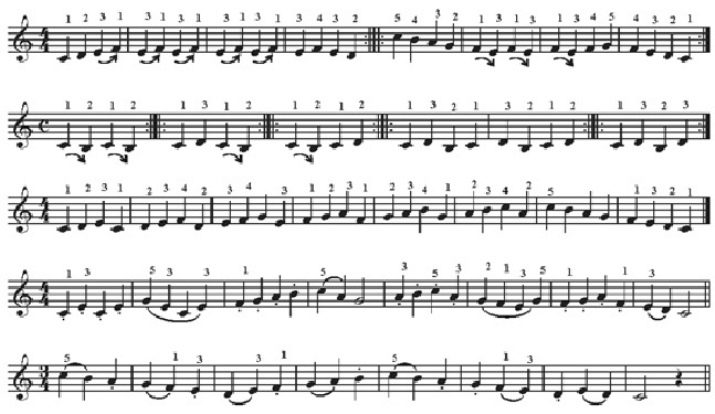
The next stage is the play of chromatic sequences (scales in E minor, G major, D major, A major, melodic A minor). The fingering forms are being improved, and the black keys are gradually used. At the same time, for interest and motivation, you can learn several melodies with an easy tempo and rhythmic structure. For example:
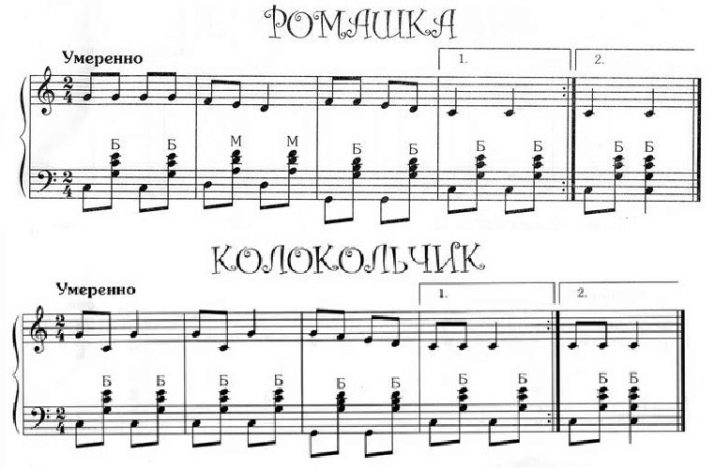
For beginners, the instructor should play the accompaniment.
To consolidate the positioning of the left hand, it is necessary to move on to more complex exercises and playing long arpeggios.

Advice
Here are some guidelines for beginners.
- Particular attention should be paid to daily music lessons... Consistency matters a lot.
- Watch out for that so that free fingers do not strain when playing, control their relaxation.
- The keys should be pressed all the wayotherwise it may be a bad habit to skip some notes when playing quickly.
- Learning a piece with both hands Try to learn the melody completely first, and then add the accompaniment to it.
- The top neck of the right keyboard should be approximately level with the musician's shoulder.... Decreasing this level will make it difficult to play high notes due to the misalignment of the right hand.
Never start the next tutorial or school lesson until you have mastered the current one perfectly.
